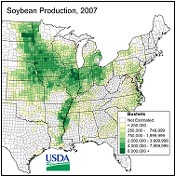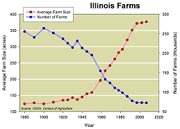Introduction to the Oral History in Illinois Agriculture Project
Oral History of Illinois Agriculture:
Restoring the Human Voice to Oral History
A National Leadership Grant from the Institute of Museum and Library Services
Dr. Robert E. Warren, Michael P. Maniscalco, James S. Oliver, Sue Huitt, Dr. Erich K. Schroeder, Illinois State Museum, Springfield, IL
Dr. Michael H. Frisch and Douglas Lambert, Randforce Associates LLC, Amherst, NY
Dr. Mark DePue, Abraham Lincoln Presidential Library and Museum, Springfield, IL
Abstract
The Illinois State Museum is exploring the rich agricultural history of Illinois with a new oral-history project. The two-year project is supported by a National Leadership Grant from the Institute of Museum and Library Services. It will create an interactive web module—the Audio-Video Barn—featuring digital oral-history interviews with people involved in agriculture and rural life in Illinois.
Sixty-four interviews are being digitized from audio tapes archived at university libraries. In partnership with the Abraham Lincoln Presidential Library and Museum, the project is also recording 60 new video interviews with people of various ages from throughout the state.
The list of interviewees reflects the tremendous breadth of agriculture in Illinois, including corn and soybean farmers, beekeepers, elk and bison ranchers, dairy farmers, college professors, 4-H kids, and growers of pumpkins, grapes, wheat, oregano, and horseradish.
In collaboration with Randforce Associates, the audio and video recordings are being digitally indexed by theme, topic, and geographical location so users can search them interactively for subjects of special interest. Digital indexing will equip Web visitors with a powerful discovery tool.
For example, someone interested in “chickens” or “farm diversification” or “women’s roles on the farm” will be able to choose an appropriate keyword or theme to easily view all of the interview segments in which those terms or concepts are discussed.
Interviews will be supplemented with walk-and-talk videos and educational activities that can be enjoyed by students of all ages. The Audio-Video Barn will give Museum and Web visitors a rich, personal view of Illinois agriculture—past, present, and future.
Illinois Agriculture

Agriculture has deep roots in Illinois, extending back 5,000 years into Native American prehistory. In the beginning, Illinois farmers produced food for their own families; now they produce food, fuel, and other materials for people throughout the world. In the U.S. today, Illinois ranks first in soybean and horseradish production, second in corn and pumpkin production, and fourth in hog production.
Illinois agriculture and rural life have changed dramatically during the past century. Technological advances have made individual farmers more productive than their parents and grandparents.
Modern planters, combines, and balers do the work of many hand laborers, alleviating the physical demands on individuals and reducing the number of people needed to produce a crop. At the same time, hybridization, genetic modification, pesticides and herbicides have greatly increased crop yield, making farmers much more productive.
Although production efficiencies have reduced the labor demands of farming and improved yields, they also pose a threat to family farms and rural communities. In 1900, Illinois had 264,000 farms averaging 120 acres in size. Farm operations were small but diverse, providing meats, fruits, vegetables, and dairy products for home consumption, as well as livestock and grain for commercial markets.

Click to enlarge.
Since 1900, the number of Illinois farms has dropped 73% and average farm size has tripled. Farming is becoming more industrialized. Many farmers now specialize on a few market crops and attempt to maximize production by buying more farmland and striving for greater yields. Others are attempting to survive by diversifying their operations and selling to specialty or niche markets.
These changes are reconfiguring social and economic landscapes in rural Illinois. The small family farms that were so common in 1900 are being replaced by large farming corporations that can operate with fewer people.
Many rural residents are migrating to urban areas in search of employment, and the rural farming population is in decline. Small towns are disappearing, as are the schools, churches, and local businesses that once served the needs of the family farm. To survive, many farmers and their spouses work jobs off the farm, some full-time. As surprising as it may seem, farmers are now in the minority in some rural communities.
Clearly, Illinois agriculture has changed dramatically during the past century.
How have these changes affected the lives of farm families and their rural communities?
What strategies have farmers used to fight off threats to the survival of their farms?
What is the future of agriculture in Illinois?
Are young people looking forward to careers in agriculture or will they join the migration to town?
OHIA Project
“You either get larger, or you get out — or you find some niche that can keep you farming.”






